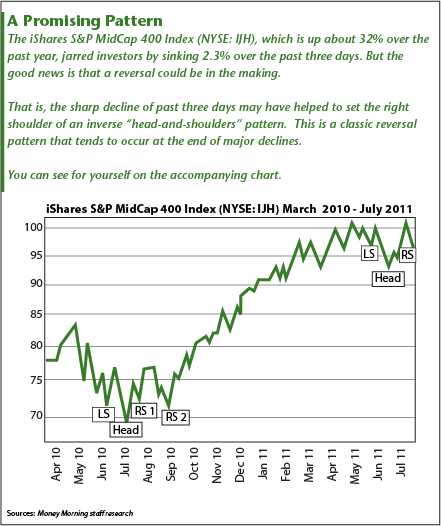By Jon D. Markman
Mid-cap stocks were one of the hottest investments of the past year until recently.
That is clearly exemplified by the iShares S&P MidCap 400 Index (NYSE: IJH), which jarred investors by sinking 2.3% over the past three trading days. The exchange-traded fund (ETF) had shot up 33% in the 12 months prior.
But the good news is that a reversal could be in the making.
That is, the sharp decline of the past few days may have helped to set the right shoulder of an inverse "head-and-shoulders" pattern. This is a classic reversal pattern that tends to occur at the end of major declines. You can see for yourself on the accompanying chart.
That is clearly exemplified by the iShares S&P MidCap 400 Index (NYSE: IJH), which jarred investors by sinking 2.3% over the past three trading days. The exchange-traded fund (ETF) had shot up 33% in the 12 months prior.
But the good news is that a reversal could be in the making.
That is, the sharp decline of the past few days may have helped to set the right shoulder of an inverse "head-and-shoulders" pattern. This is a classic reversal pattern that tends to occur at the end of major declines. You can see for yourself on the accompanying chart.

I have marked the left shoulder, head and right shoulder of the pattern that is unfolding in the chart above on the right.
This is exactly the pattern that has ended all major declines in the past two years. The most recent example was last summer right around this time. In that case, the market moved up briskly to a high in early August before coming back down to set a second right shoulder. That's a well-known variation that could easily occur this time as well.
The psychology of a head-and-shoulders bottom is what is important: Shares move down to the left shoulder on bad news, rally to a "neckline," then sink deeper than the first low on worse news to a "head." Then they rally back to the neckline before sinking one or two more times on bad news to levels that are equal to the first shoulder and not as low as the head. Finally, a new cadre of buyers come in, believing that prices are finally low enough, and push the market back up to the neckline.
To "validate" this pattern, prices need to shoot back over that neckline on higher-than-average volume and not return. Technical traders argue that the index should follow up with a subsequent advance that is equal to the depth of the move from the neckline to the head.
In case of IJH, the calculation is 101.1 - 92.5 = 8.6. So then you add 8.6 to 101.1 to get a target of 109.7. That would be a 14% move from the current quote, which obviously would be welcome.
It's hard to say whether a similar move could occur in the absence of any extraordinary monetary policy efforts by the U.S. Federal Reserve. But it gives you an idea of what could happen if earnings and outlooks are better than expected this month, or if the market gets a hint that a third round of quantitative easing may be on the way.
And of course, it is possible that the pattern will not be validated.
A move back down, under 96, would invalidate the pattern and set up a test of the 92.5 area. So watch the MidCap 400 carefully, and be prepared to act.
Just keep in mind that a move back to the neckline is not enough. The index needs to move emphatically through that level. If the old high brings out sellers that push the market back down, we'll keep an eye out for the potential of a second right shoulder much like last year.
They never make it very easy on us, but if you stay on your toes and really watch these levels carefully you can pick up a lot of clues that will augment your returns for the year in a big way.
No comments:
Post a Comment